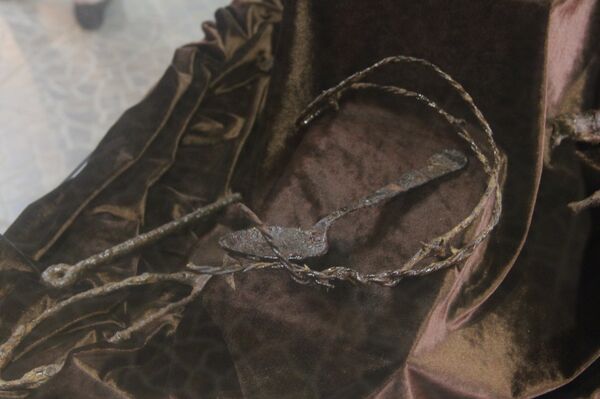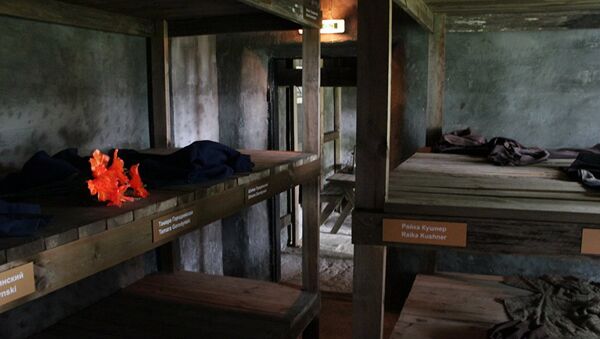Intrigued by his statements, Sputnik decided to learn more about the story of his family’s daring escape from the Nazis and the horrors they had to endure during their stay in ghetto.
Before the war the Kushner family lived in the town of Novogrudok, located in modern-day Belarus, where they owned a house and a store. The patriarch of the family and Jared's great-grandfather, Zaidel Kushner, was in the business of making fur coats and hats, which earned him the nickname Hatter. He had three children – one son, Chanon and two daughters, Leia and Rae (the latter would eventually become Jared’s grandmother).
It should be noted that back then Jews comprised over the half of the population of Novogrudok.

Just like the rest of the Jews living in the city, on December 7, 1941 the Kushner family ended up in a Nazi ghetto, Tamara Vershitskaya, former head of the Jewish Resistance Museum in Novogrudok, told Sputnik.
Only about 1,500 of the 6,000 Jews living in Navahrudak survived the so called 'selection' process that followed, when the Nazi officers apparently decided who would live and who would die simply by checking how many children they had and their respective occupations.
The Kushner family was lucky to be among those who were allowed to live. Their luck also held in summer, 1942 when they ended up among the 500 ghetto residents who were transferred to a closed labor camp – those who were left behind ended up being executed by the Nazis.
"I know nothing of what kind of a man Zaidel was, but I do know that he tried to make his family’s stay in the ghetto as comfortable as possible. For example, when Jews from the first ghetto were forced to perform hard labor in the city, he used bribery to ensure that his son was exempt from this practice," Vershitskaya said.
On May 7, 1943 about half of the ghetto’s inmates, some 250 people, ended up executed by their jailors.
According to Vershitskaya, Zaidel’s wife, Hinda, and Chanon both ended up among those sentenced to death. But while Hinda resigned to her fate and even tried calling for her husband and daughters to join her and die together, Chanon managed to hide from the Nazis and avoid the firing squad.
This mass execution became the pivotal moment for the inmates – shocked and enraged by the deaths of their friends and loved ones, they decided to stage an escape.

It took the captive Jews four months to dig a 200-meter-long tunnel to escape the ghetto, they dug it using spoons, forks and scrap iron, literally scraping their way to freedom.
"When we found a German military entrenching tool, I thought it was used for digging, but one of the men who helped build the tunnel explained that you couldn’t use a spade like that because the ground was mostly clay. They used spades like that to load soil taken from the tunnel into sacks sewn from the clothes of those who were executed. The soil was then hidden in attics, away from the prying eyes of the Nazis," Vershitskaya explained.
The prisoners managed to outfit their tunnel with a ventilation system made of water pipes dug into the ground, and even provide lighting by tapping into the power source of one of the guards’ floodlights.
On the night of September 26, 1943 the prisoners descended into the tunnel one by one, marking the beginning of what became one of the largest, most successful Jewish rescue operations in the German-occupied territories.
"The guards entered the building where the tunnel entrance was located only when all of the inmates were already inside the tunnel. They started shooting and in the morning they launched a sweep of the surrounding areas. And while the escape itself was very well organized, many of the escapees simply didn’t know what to do afterwards. Many of them simply went to sleep immediately after reaching the forest. Therefore, only two-thirds of them eventually survived," Vershitskaya said.
Chanon Kushner was one of those killed by the pursuing guards, while Zaidel and his daughters were among those 152 escapees who joined the Bielski partisans.
The exploits of the Kushner family as part of the resistance are less known, though Zaidel likely toiled at a workshop making equipment for the guerrillas while his Leia and Rae could’ve acted as lookouts, Vershitskaya speculated.
What is known however is that during that time, Rae Kushner met her future husband, Joseph Berkowitz, who later changed his surname to Kushner prior to the family’s immigration to the US.
The Kushner family, along with the families and relatives of other survivors, helped create the exposition at the Jewish Resistance Museum dedicated to the ghetto and to prisoners’ daring escape, both by recounting those horrible events and by providing financial aid.
"There are many successful people among the former inmates of this ghetto. Jack Kagan is a millionaire, Leibowitz is a millionaire, the Kushners are billionaires. I believe there is an explanation for that: if those people could survive here, imagine what they were capable of during peacetime," Vershitskaya concluded.





